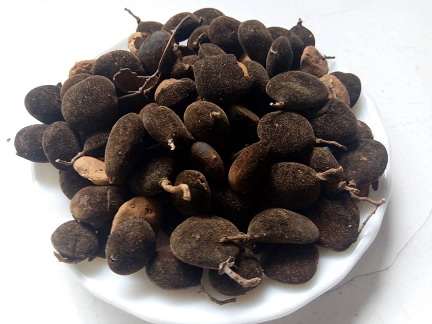
Dialium indium or Wild Dialium Guineense is the scientific name for the black velvet tamarind. It is a seasonal fruit native to Africa, particularly tropical areas such as West Africa.
It is commonly referred to as African velvet tamarind and is known as cheleku or Icheku in the Igbo language, as Awin in Yoruba, and Hausa calls it tsamiya-kurm. Some people also refer to it as licki-licki in Pidgin English.
However, black velvet has a slightly hard shell that is breakable, orange pulp that is sticky when wet, with a round brown color seed.
The seeds are utilized for a variety of applications, including culinary, medicinal, and traditional uses.
Black velvet tamarind, which contains the root, leaves, and bark of the black velvet tamarind tree, has been used in the treatment of numerous ill-health issues traditionally and is proven to be successful.
It’s used to treat malaria, diabetes (since it lowers blood sugar), pain, bronchitis, and a variety of other ailments.
Awin, Icheku, or Velvet tamarind, there are essential nutrients such as potassium, sodium, iron, vitamin C, and magnesium, are abundant in this fruit. While reading the article, you will also learn about the nutritional benefits of African velvet tamarind.
Uses and Benefits of Black Velvet Tamarind – Icheku | Awin
Cures Malaria
Malaria is caused by the Plasmodium parasite, which you may readily get by being bitten by infected mosquitoes. Nausea, vomiting, sweating, fever, headache, muscular soreness, and weariness are some of the symptoms you may experience.
Malaria is without a doubt one of the most frequent illnesses in Nigeria, with over one million cases reported each year, according to data.
One of the great benefits of velvet tamarind is that it can aid in the treatment or prevention of malaria. This fruit’s leaf extract has antiplasmodial properties, which helps to slow the growth of Plasmodium falciparum, the main cause of malaria.
Improves Lactation
The black velvet tamarind pulp is known to contain nutrients required for milk secretion, implying that it aids breastfeeding.
This makes it beneficial for pregnant women and nursing moms, as it is popularly thought that it will aid enhance breast milk supply, despite the lack of scientific evidence.
It is also used in the treatment of illnesses, particularly those affecting the genitals, in some sections of Nigeria and other African nations where it is widely utilized.
Treats Stomach Ulcer.
Open sores on the interior lining of the esophagus, stomach, or small intestine are referred to as stomach or gastric ulcers. Stomach discomfort, belching, heartburn, nausea, searing sensation along the tummy, indigestion, appetite changes, and other symptoms are typical. Furthermore, chronic use of pain medications or nonsteroidal anti-inflammatory medicines, infection with the Helicobacter pylori [H. Pylori] bacteria, and excessive alcohol use, to name a few, are all known causes of stomach ulcer.
The African Velvet Tamarind Can Help You Get Rid of Ulcers. Velvet tamarind leaf extract has the capacity to stimulate stomach mucus production.
Can Aid in the Prevention of Hypertension
The leaves are also diuretic, promoting the generation of urine and so making it simpler for the heart to pump blood. This lowers the risk of hypertension.
Reduces Inflammation
The vitamin C concentration of black velvet tamarinds aids in the fight against microbial infection and lowers inflammation in the bronchial tube, preventing cancer, which has inflammation as one of its underlying causes.
Bronchitis patients can benefit from black velvet tamarinds, according to research, because they provide enough vitamin C to minimize bronchial tube lining inflammation.
Promotes Digestive Health
Non-starch polysaccharides in the pulp of black velvet tamarind aid to maintain a healthy digestive tract and lower blood cholesterol.
It is not digested in the body (small intestine), thus it gives no calories to the body, which is helpful for weight loss, but it also ensures that the digestive system is working properly.
Acts as an Antioxidant
It’s also known as an Alpha Hydroxy Acid, and it can help exfoliate the skin by eliminating dead skin cells from the pores.
It includes tartaric acid, a powerful antioxidant that protects the body from free radicals that harm the body’s critical organs and cells.
Tartaric acid may be added to foods and even used as a leavening agent in bakeries, but black velvet tamarind has it naturally, so instead of adding it to your meals or baking, you may obtain it from this fruit.
Cures Tooth Ache and Improves Oral Hygiene
The plant has been used as an oral cleaner since it was first found.
The saponin in the stem of the African Velvet Tamarind, which is used as a chewing stick, cleans the teeth.
If you have plaque or cavities, the stem of this wonderful plant can help you get rid of them and whiten your teeth. The decoction of stem bark is also used to cure the above stated diseases.
Stops Diarrhea and Relieves Menstrual Cramps.
African Velvet Tamarind stem bark extract also has considerable analgesic properties, allowing it to be used to treat menstruation discomfort, according to research.
Hemorrhoids or Pile
Piles are bulging veins in the anal canal that create a lot of pain for people who have them when they need to discharge excrement.
Other Amazing Health Benefits of Black Velvet Tamarind – Icheku | Awin
- Treats Scurvy and Wounds
- Boosts immune system
- Treats wound
- Maintains good metabolism
- Cures dry eyes
- Prevents anemia
- Useful for pregnant women
- Treats bronchitis
- Maintains healthy kidney
- Fights harmful microorganisms
- Regulate cell functions


